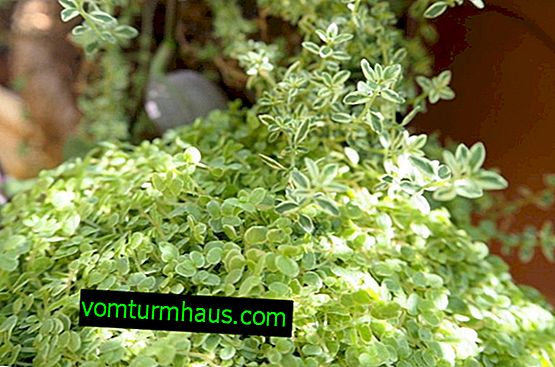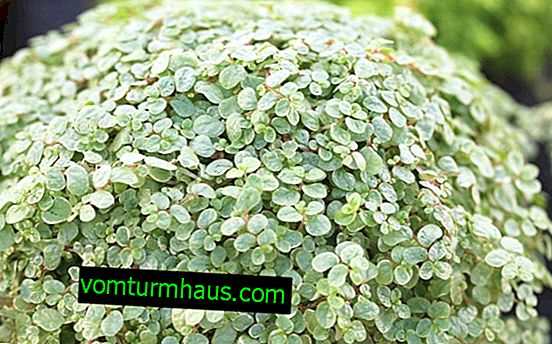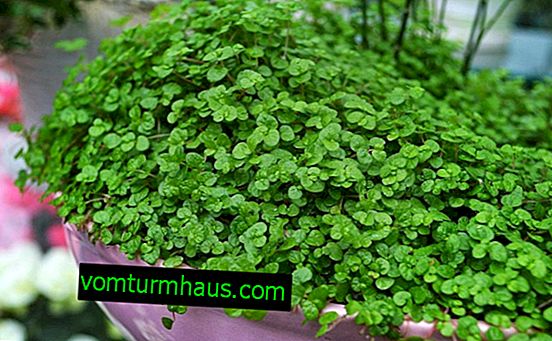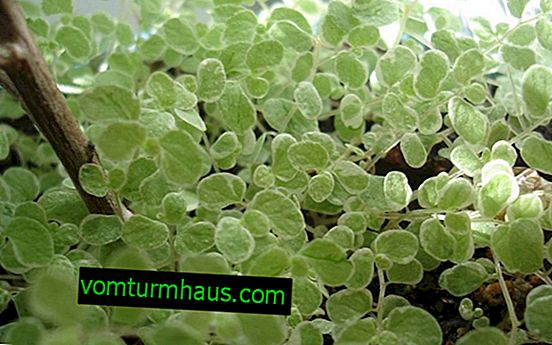Salting flower: home care
Soleirolia is not known to many flower growers, but real connoisseurs of exotic plants must settle it at home. This miniature plant gives its bright and unique color throughout the year, and also saturates the room with fresh oxygen. However, often the plant withers and dies at home. Next, we will tell you in detail what is needed for salt growth for successful growth, and also list the main secrets of its successful cultivation.
Botanical description of the plant
Soleoli is a fast-growing herbaceous plant belonging to the genus of the same name. The homeland of this species is considered to be the humid subtropical zones of the Mediterranean, where it is still widely found in the wild. This plant was discovered at the beginning of the 19th century on the territory of the island of Corsica, by the botanist Joseph Francois Soleirol. The plant is a creeping species, it is characterized by a highly branched thin stalk, divided into several main shoots. In places of mass distribution of salt, it forms a thick elevated carpet, near forest stands, ponds, and in meadows.
Small leaves, 2–5 mm in diameter, often develop on the stem. They are located on small petioles and differ in a round or oval shape, as well as a glossy sheen and a saturated green, golden, silver or yellowish tint (depending on the variety).
The root system in saltolysis is fibrous, branched, the roots are often thin and numerous, creeping type, spread widely over the soil surface.

After flowering, the fruit does not form on the plant.
Did you know? The closest relative of salinity is nettle, which is widespread in temperate and northern climates. In culture, this species is used for garden or indoor decoration. In warm regions with a subtropical and tropical climate, salinolemia is planted as a cover plant, around tree-like vegetation and tall bushes. In the temperate and northern zones, the plant is cultivated in room conditions, in small hanging containers.




















Main varieties
Among florists, few varieties of salt exposure are known. Often they have uniform morphological features, with the exception of foliage color. This made it possible to use the view for decorative arrangement of any landscape, as well as the interior.
The most common types of salinolysis available on the market are:
- aurea - different foliage saturated yellow-green or golden color;

- argentea - has a rather rare light silver color of leaves;

- green - the plant is remembered for saturated light green leaves. Unlike other varieties, its foliage grows no more than 2 mm in diameter;

- variegata - the variety is characterized by leaves of a deep dark green color, with a thin white border.

Benefit and harm
Soleoli is one of the species that is absolutely safe for humans and pets. Juice and all kinds of secretions of the plant are absolutely non-toxic, even if they enter the digestive tract. Therefore, flowerpots with a bush can be hung in any part of the house, from the living room to the children's room. It is worth noting that this type brings only benefits to people.
Thanks to the exotic appearance and all kinds of colors, it can be successfully fit into any interior. The plant is considered to be evergreen, therefore, in late autumn and throughout the winter, it will delight the eye with a rich color of foliage and improve mood. In addition, like any home plant, salinolysis contributes to the regulation of humidity in the room, as well as cleaning the air from harmful toxins and dust.
Did you know? The people often call salinity “indoor wood lice”, this is due to the fact that the plant resembles a reduced copy of wood lice, the most famous weed among gardeners.
Conditions for successful cultivation
Among experienced gardeners and lovers of saltworks, it is considered one of the easiest indoor species to grow, so almost everyone can cultivate it on their windowsill. But often, especially novice growers, make many mistakes when growing this bush, because of which it is sick for a long time, and then loses its decorative value.

Placement and lighting
This plant grows well in any conditions, so it can be absolutely safely grown both in the shade and in direct sunlight. However, the most aesthetically valuable specimens of the species develop only on well-lit window sills, with intense diffused light. At noon, a flowerpot with a bush should be protected from intense light, as it can cause burns on foliage, especially in young specimens.
The flowerpot can be kept absolutely on any windowsill, but it is best if the plant is located near the eastern, northern and western windows. If your windows face south, it is imperative that you move the solarium deeper into the room, away from intense sunlight. A place with a flowerpot must be located near the outlet, since in winter the bush must be highlighted with a table lamp.
Important! In order for the varietal features of saltworks to be manifested most clearly, it should be grown only in well-lit rooms. With a lack of lighting, the color of the plant fades.
Temperature and humidity
All sorts of species like the moderate temperature regime, within +20 ... + 25 ° С. In winter, the bush can withstand a seasonal decrease in air to + 15 ° C, but cooling to + 8 ° C can cause its death. At the same time, it responds well to high humidity in the room, therefore, if possible, this indicator should be necessarily maintained within 60–80%. For this, the bush is moistened once every 1-2 days with a spray gun. But, with an increase in air temperature above + 25 ° C, the multiplicity of the procedure is increased to 1-2 humidifications per day (early in the morning and late in the evening).
Home Care
Despite the fact that salinolysis belongs to the southern thermophilic species, its maintenance at home does not bring much trouble. However, the cultivation of this plant still has some features.

Watering
It is often necessary to water the celyrole, it is a moisture-loving species in which constant moisture plays a key role in life. Therefore, the soil in the pot is watered regularly. In summer and spring, the plant loves more intensive watering, in connection with this, the procedure is carried out at least 1 time in 2-3 days, in winter the frequency of watering is reduced, to 1 procedure in 3-5 days. For irrigation use only soft, settled water, room temperature.
Important! Sown soil must be moistened daily, otherwise the germination of sprouts worsen.
Water the flowerpots with horse and grassroots methods, alternately. Thus, it is possible to completely saturate the entire soil with water. This is one of the main requirements of the plant, since even a short drying of the roots leads to their withering and death. When watering, be sure to remember that caleyrole does not like stagnation of moisture, so excess water must be removed from the flowerpot.
Fertilizer application
Best of all, this decorative bush responds to top dressing with organic fertilizers, especially during the period of active vegetation. For this, a liquid solution of mullein or chicken droppings (1:15) is added to the flowerpots. They can be replaced with “Peat Oxidate” (1% solution) or other organic preparation for cultivated plants. In summer, pots are fertilized no more than 2 times a month, with a uniform interval between each procedure. In winter and late autumn, the soil is fertilized less often, not more than 1 time per month.

Pruning
This house bush does not need to be pruned; it belongs to evergreens with a long life cycle. But in order to achieve the necessary decorative value, it still needs to be cut. Sanitary removal of shoots is carried out as necessary, first of all, old or wilted shoots and leaves are removed, which helps to rejuvenate the bush and extend its viability. Decorative pruning is performed no more than 1 time per month.
Transfer
A flower transplant is carried out as necessary, but not more often than 1 time in 2 years. The most favorable for this period is considered to be the beginning or middle of spring. At this time, the plant has the most active metabolism, which favorably affects its adaptation to new conditions. To do this, use deep garden containers made of plastic, metal and glass. The size of the new pot must necessarily be 7-10 cm larger than the rhizome in diameter, otherwise the expediency of the procedure is reduced. For transplantation, a soil mixture prepared from equal parts of turf, sheet land and river sand is used.
Find out how and when to transplant indoor plants.
Use only sterile soil.
Disinfect her:
- roasting in the oven for 20–25 minutes, at + 125 ° C;
- freezing 2-3 days in a freezer, at –20 ...– 25 ° С;
- wetting with a 1% solution of potassium permanganate.
Transplanted salinity as follows:
- Prepare a container for transplantation. It is sterilized with 1% potassium permanganate or 70% alcohol solution.
- Put a drainage layer of fine expanded clay or gravel 2–4 cm thick on the bottom of the tank.
- Pour new soil over the gravel with a layer of 2-3 cm.
- Carefully remove the bush along with the substrate from the old pot and transfer it to a new pot.
- Fill the gaps between the roots and the flowerpot with soil.
- Water the container, and feed it after 14–20 days.
Video: transplanting salinology
Propagation at home
Salioli is able to multiply both by seeds and parts of the bush. But, most often, a new plant is obtained by dividing the bush in half. For this method, only adult specimens are used, with an age of at least 2-3 years. Dividing is carried out in the spring, combining reproduction with transplantation.
Propagate the salt division by so:
- Disinfect the soil and pot (according to the method described above).
- Fill the container with fine gravel (2–4 cm) and then with a clean substrate.
- Take the bush out of the pot, remove excess soil from the roots. Do this as carefully as possible, avoiding damage to the root system.
- Cut the bush in half with a sharp knife.
- Create a small indentation in the containers with the substrate, put a divide into it.
- Fill the roots with a substrate and water the pot.
- After 2-3 weeks, the plant will take root in a warm, well-lit place, after which it can be fed.
Video: bush propagation of salinity
Sometimes new plants get sown seeds. Despite the fact that at home, salinolysis rarely gives seeds, this method is indispensable if you want to grow a new variety. Germinate seeds in early March.
The procedure involves the following actions:
- Sterilize the germination pot and soil.
- Soak the seeds in a 1% potassium permanganate solution for about 15 minutes (for disinfection).
- Fill the pots tightly with soil for germination with clean soil. A mixture of sheet, soddy ground and sand (1: 1: 1) is best suited for this.
- Spread the seeds evenly over the surface of the soil, and then sprinkle them with soil in a 1-2 cm layer.
- Pour sprouting containers, cover with polyethylene and place in a well-lit, warm (+22 ... + 25 ° С) place.
- After emergence, in the phase of 2-3 leaves, the polyethylene is removed from the flowerpots, and the sprouts dive into separate pots.

Growing difficulties
Problems with the cultivation of salinolemia are rare, this plant is considered resistant to all kinds of infections, but often if the optimal conditions are not maintained, the bush can become seriously ill. Despite the fact that such pathologies often develop quite slowly, if untimely eliminated, they can cause a decrease in the immunity of the bush, and with it its death.
The main problems that arise during the cultivation of salinolysis and methods for their treatment:
| Problem | The main reason | Remedies |
| Drying and dying leaves | low soil and air humidity | it is necessary to increase the frequency of watering, as well as the amount of hydration of the leaves |
| Blanching of leaves and inhibition of shoot growth | soil nutrient deficiency | the bush is replanted in new soil, the number of top dressings is increased |
| Plant stretching | lack of lighting | the flowerpot needs to be moved to a more lighted place |
| Withering of foliage, silver-brown spots are observed on leaflets | sunburn | the flowerpot is shaded with tulle or other shelter |
| The bush fades, the color of the leaves changes to yellow | waterlogging of the soil | the frequency of watering and moistening the bush should be halved |
| The leaves turn brown and curl, a pale coating may be observed on the lower part | parasite damage (aphid, spider mite) | the bush is treated twice, with a gap of 14 days, treated with solutions of Intavir (1 tablet / 0.5 l of water), Vertimek (5-10 ml / 10 l of water), Actofit (10 ml / l of water), “Aktara” (1 g / 10 l of water) or “Fitoverm” (2 ml / l of water). |







